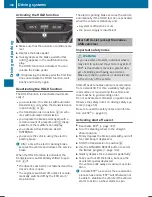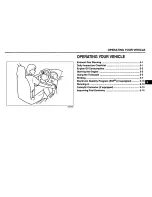
R
Drive slowly and evenly, if necessary at a
walking pace.
R
Ensure that the wheels are in contact with
the ground at all times.
R
Drive with extreme care on unfamiliar off-
road routes where visibility is poor. For
safety reasons, get out of the vehicle first
and survey the off-road route.
R
Check the depth of water before fording riv-
ers and streams.
R
Watch out for obstacles.
R
Take care when turning on an uphill or
downhill slope or when driving across a
slope. The vehicle could otherwise tip over.
R
Always keep the side windows and the pan-
orama roof with power tilt/sliding panel
closed during the journey.
R
Do not deviate from marked routes.
R
Do not use the HOLD function when driving
off-road, on steep uphill or downhill gradi-
ents or on slippery or loose surfaces. The
HOLD function cannot hold the vehicle on
such surfaces.
Checklist before driving off-road
X
Engine oil level: check the engine oil level
and add oil if necessary.
When driving on steep gradients, the engine
oil level must be sufficiently high to ensure a
correct oil supply in the vehicle.
X
Wheels and tires: check the tire tread
depth and tire pressure.
X
Check for damage and remove any foreign
objects, e.g. small stones, from the wheels/
tires.
X
Replace any missing valve caps.
X
Replace dented or damaged wheels.
X
Rims: dented or bent rims can result in a
loss of tire pressure and damage the tire
bead. Before driving off-road, check the
wheels and replace them if necessary.
Checklist after driving off-road
!
If you detect damage to the vehicle after
driving off-road, have the vehicle checked
immediately at a qualified specialist work-
shop.
X
Deactivate off-road program (
Y
page 132).
X
Deactivate DSR (
Y
page 169).
X
Clean the headlamps and rear lights and
check for damage.
X
Clean the front and rear license plates.
X
Clean the wheels and tires with a water jet
and remove any foreign objects.
X
Clean the wheels, wheel housings and the
vehicle underside with a water jet; check for
any foreign objects and damage.
X
Check whether twigs or other parts of plants
have become trapped. These increase the
risk of fire and can damage fuel pipes, brake
hoses or the air bellows of the axle joints
and propeller shafts.
X
After the trip, examine without fail the entire
undercarriage, wheels, tires, brakes, body-
work structure, steering, chassis and
exhaust system for damage.
X
After driving in sand, mud, gravel, water or
similar dirty conditions, have the following
checked and cleaned:
R
brake discs
R
wheels
R
brake pads
R
axle joints
X
If you detect strong vibrations after off-road
travel, check for foreign objects in the
wheels and drive train and remove them if
necessary. Foreign objects can disturb the
balance and cause vibrations.
Driving over poor road surfaces places greater
demands on your vehicle than driving on nor-
mal roads. After driving off-road, check the
vehicle. This allows you to detect damage
promptly and reduce the risk of an accident to
yourself and other road users.
Driving on sand
Observe the following rules when driving on
sand:
R
Activate the off-road program (
Y
page 132).
R
Avoid high engine speeds.
R
Use the left-hand steering wheel paddle
shifter to shift to a lower gear appropriate to
the terrain.
Driving tips
155
Dr
ivi
ng
an
d
parki
ng
Z
















































